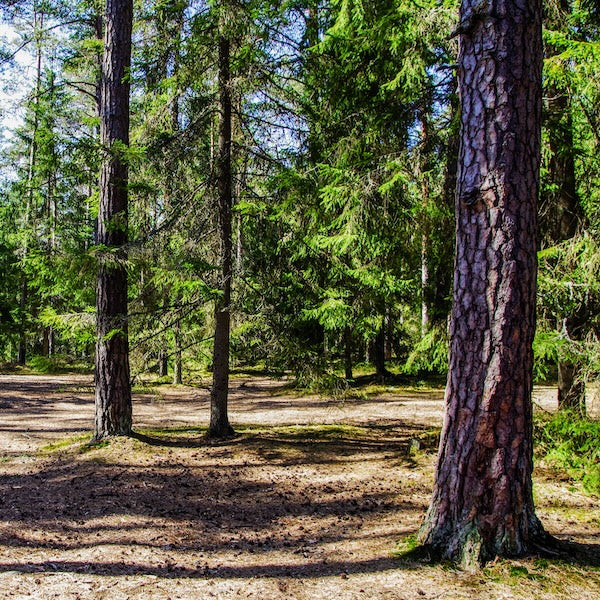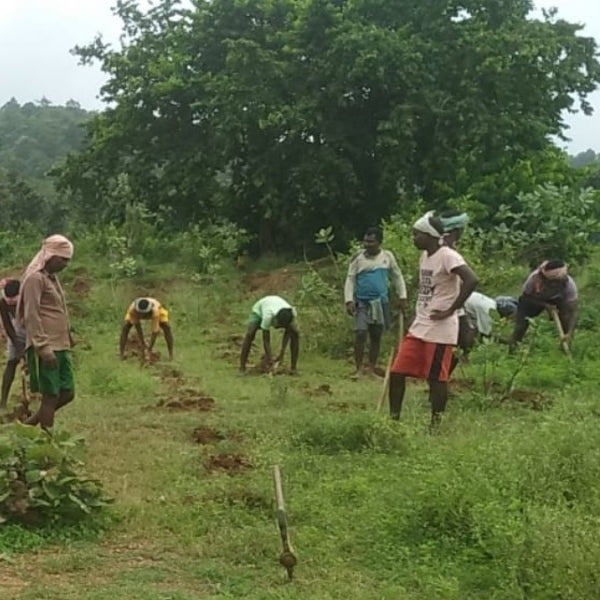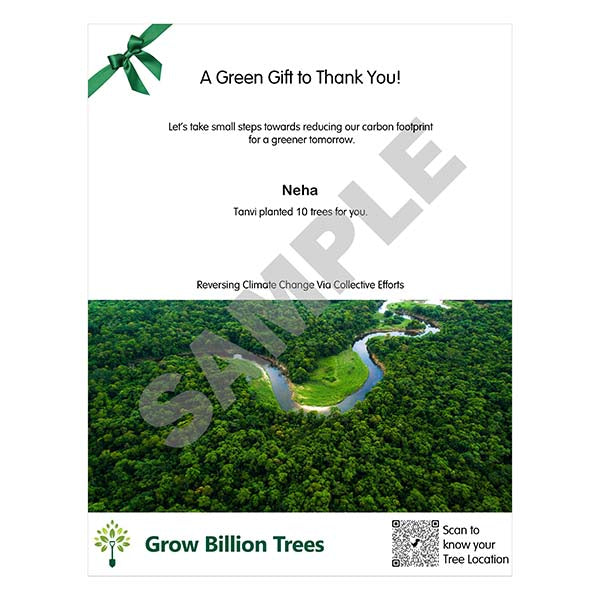Trees for Carbon Neutral Meetings
Trees for Carbon Neutral Meetings
🌳 2-3ft Tree + 3 Years Nurturing + Geo-Tagged
💡 Tip: Plant a tree on behalf of each family member
Couldn't load pickup availability
What you get ?
Tree(s) Plantation
Tree(s) Plantation
A tree(s) native to the region will be planted within 7 -10 days, and post-plantation monitoring will be thoroughly managed.
*You will receive an email/whatsapp notification immediately after the tree(s) plantation. or you can check the current status by logging into "My Account" anytime.
e-Greeting Card of Tree(s) Plantation for Gifting
e-Greeting Card of Tree(s) Plantation for Gifting
If you want to gift these tree(s) to your loved ones, You can generate an e-Greeting card for tree(s) plantation by logging into "My Account" after placing order.
*Please generate it within 5 days of placing the order.
e-Certificate of Tree(s) Plantation
e-Certificate of Tree(s) Plantation
A e-certificate of Tree(s) Plantation with the project details will be issued in your name after tree(s) plantation.
*You can download it from "My Account".
Geotag of your Tree(s)
Geotag of your Tree(s)
You can immediately track the live location of the project chosen for your tree(s) plantation, by logging into "My Account" or, by scanning the QR code on the certificate.
*You can see Your Name in respective Project/Forest.
If you want to gift these tree(s) to your loved ones, You can generate an e-Greeting card for tree(s) plantation by logging into "My Account" after placing order.
View full details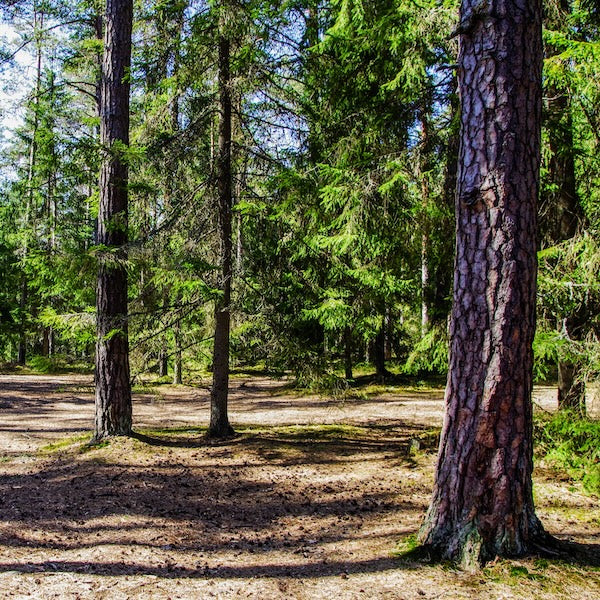
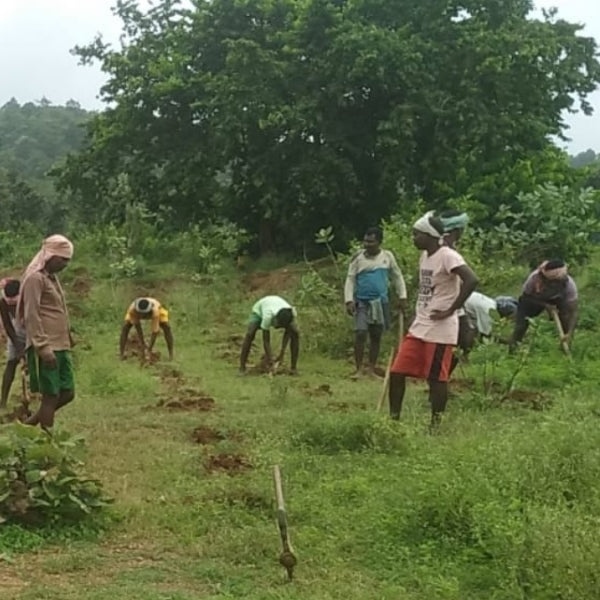
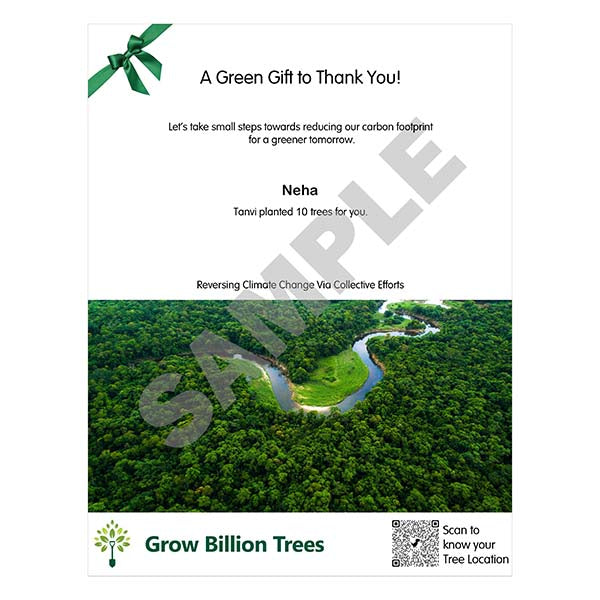
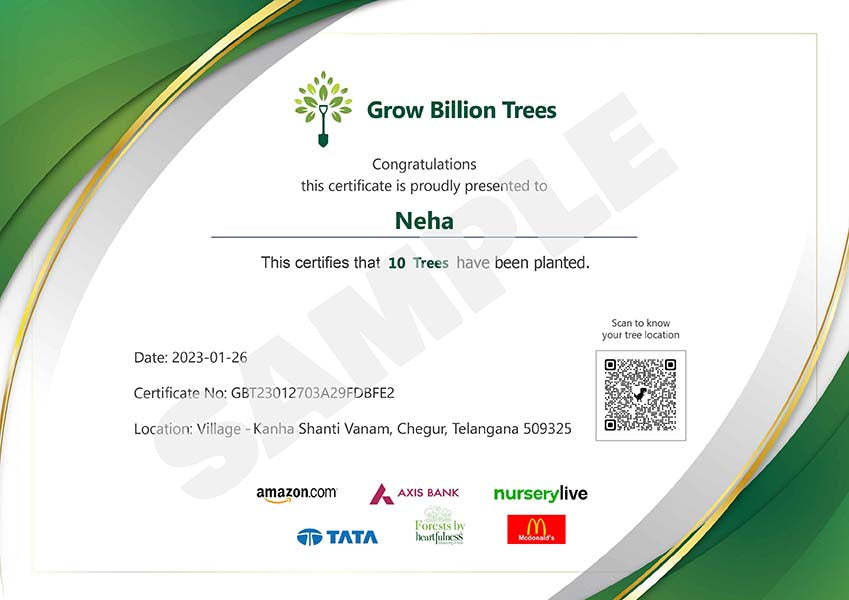
Did you know that planting trees is a powerful way to combat climate change and reduce our carbon footprint? By absorbing carbon dioxide Read more
Trending
Carbon Neutral Meetings with Tree Plantation
Description:
Did you know that planting trees is a powerful way to combat climate change and reduce our carbon footprint?
By absorbing carbon dioxide from the atmosphere and storing it in their wood, leaves, and roots, trees help to mitigate the greenhouse effect.
In addition to capturing carbon, trees offer numerous other environmental benefits, such as improving air quality, providing habitat for wildlife, and reducing erosion.
Scope:
- Enhancement of Biodiversity
- Increase in Green Cover
- Reduction of Man-Animal Conflict
- Generation of Rural Employment
- Improvement of Wildlife Habitats
Tree Species:
The species of trees that are planted depend on the project, and they are chosen based on their native habitat in the corresponding ecological zone.
Why trees?
Planting trees is an effective and natural way to help reduce our carbon footprint. Trees absorb carbon dioxide from the atmosphere and store it in their wood, leaves, and roots, which helps to mitigate the greenhouse effect and combat climate change.
In addition to capturing carbon, trees provide numerous other environmental benefits, such as improving air quality, providing habitat for wildlife, reducing erosion, and stabilizing soil. They also have the ability to beautify landscapes, provide mental health benefits, and create a sense of accomplishment.
By planting trees, individuals and communities can take an active role in offsetting carbon emissions and promoting sustainability. Whether you plant a tree in your own yard or donate to a tree-planting organization, this is a simple and impactful way to make a difference and reduce your carbon footprint. Every tree makes a difference, and together, we can make a significant impact on the health of our planet.
Social Impact:
Planting trees can have a number of social and community benefits, in addition to helping to reduce carbon emissions and combat climate change. Some of the ways in which tree planting can positively impact the community include:
-
Encouraging community involvement: Planting trees as a community activity can bring people together and promote social connections.
-
Fostering a sense of belonging: Participating in a tree-planting event can help to build a sense of ownership and pride in the community.
-
Promoting education and awareness: Tree planting can provide an opportunity for education and learn about the environment, raising awareness about the importance of trees and the role they play in the health and well-being of the planet.
-
Inspiring positive change: By planting trees and sharing the experience with others, you can inspire others to take action and make a positive impact on the environment. This can have a ripple effect, promoting sustainability and positive change in the community and beyond.
Overall, tree planting can be a meaningful and impactful way to contribute to the health and well-being of the community and the environment.
Carbon sequestration
Trees absorb and store carbon dioxide from the atmosphere, reducing greenhouse gas emissions.
Reforestation
Planting trees to restore lost or degraded forest ecosystems, increasing carbon storage and promoting biodiversity.
Agroforestry
Combining trees with agriculture to sequester carbon, improve soil health, and support food production.
Urban forestry
Planting trees in cities to reduce the urban heat island effect, improve air quality, and provide ecosystem services.
Forest conservation
Protecting existing forests to maintain carbon storage and other ecological services, including habitat and water regulation.
Carbon offsetting
Funding projects that reduce greenhouse gases to compensate for carbon emissions.
Afforestation
Planting trees in areas where there was no previous forest cover, creating new carbon sinks and promoting biodiversity.
Biomass energy
Generating renewable energy using trees and other plant material, reducing greenhouse gas emissions from fossil fuels.
Carbon footprint
The amount of greenhouse gases emitted by an individual or organization, which can be reduced through tree planting.
Tree species selection
Choosing the most suitable tree species for a particular location to maximize carbon sequestration and ecosystem services.
Soil carbon
Trees can improve soil carbon content, increasing soil fertility and carbon storage.
Shade trees
Planting trees to provide shade and reduce cooling costs, reducing energy consumption and greenhouse gas emissions.
Tree planting programs
Organized efforts to plant trees, often with a focus on carbon sequestration and ecosystem services.
Forest restoration
Restoring degraded or damaged forest ecosystems, increasing carbon storage and biodiversity.
Community forestry
Involving local communities in forest management and restoration, promoting social and environmental benefits.
Forest certification
Certifying sustainably managed forests to ensure the maintenance of carbon storage and other ecological services.
Green infrastructure
Incorporating trees and other vegetation into urban design to provide multiple benefits, including carbon sequestration and improved air quality.
Ecological restoration
Restoring degraded ecosystems, including forests, to promote carbon storage and biodiversity.
Forest-based livelihoods
Supporting local communities through sustainable forest management, promoting both economic and environmental benefits.
Tree care and maintenance
Proper care and maintenance of trees to ensure their health and longevity, maximizing their carbon sequestration potential.
Most Popular
Impact of your Tree
-
Releases Oxygen
A mature tree produces around 120 kilograms of oxygen per year, which is sufficient for one human per year.
-
Reduces Air Pollution
A tree absorbs harmful gases like CO2, NO2 released by factories and vehicles, which can have serious health problems for us
-
Removes CO2
A Tree removes 22 KGs of CO2 from atmosphere per year, which is equivalent to the CO2 realeased by a human in 10 days.
-
Cooling Effect
A Tree generates cooling effect of around 10 room size ACs by providing shade and through a process of transpiration.
Special Plantations
FAQ
How much does it cost to plant a tree for reducing carbon footprint?
The cost of planting a tree start at Rs 199. It can vary depending on the tree species, size, and where it is located.
What is the role of trees in reducing carbon footprint?
Trees absorb carbon dioxide from the atmosphere and store carbon in their tissues, making them an important tool in mitigating greenhouse gas emissions and reducing carbon footprint.
How many trees are needed to offset carbon footprint?
The number of trees needed to offset carbon footprint varies depending on factors such as the size of the carbon footprint and the species of tree. However, as a general rule, it takes around 1,000 trees to absorb the carbon dioxide emissions of one person per year.
How can planting trees reduce carbon footprint?
Planting trees helps to remove carbon dioxide from the atmosphere, which in turn reduces the amount of greenhouse gases in the atmosphere. Trees absorb carbon dioxide during the process of photosynthesis and store it in their trunks, branches, and roots.
What are the best tree species for reducing carbon footprint?
Trees that grow quickly and have high carbon sequestration rates, such as Douglas fir, larch, and spruce, are among the best species for reducing carbon footprint.
How does deforestation contribute to carbon footprint?
Deforestation results in the release of carbon dioxide into the atmosphere when trees are cut down or burned. This contributes to the increase in greenhouse gas emissions and the exacerbation of climate change.
How long does it take for a tree to absorb carbon dioxide?
The time it takes for a tree to absorb carbon dioxide varies depending on the species of the tree and its growth rate. However, on average, a tree can absorb up to 48 pounds of carbon dioxide per year.
Can planting trees alone solve the issue of carbon footprint?
While planting trees is an important tool in reducing carbon footprint, it alone cannot solve the issue. Reducing greenhouse gas emissions from other sources such as transportation and industry is also crucial.
How does urban tree planting contribute to reducing carbon footprint?
Urban tree planting can help to absorb carbon dioxide emissions from sources such as cars and buildings, thereby reducing carbon footprint in cities.
What is agroforestry and how can it help to reduce carbon footprint?
Agroforestry is the practice of integrating trees into agricultural landscapes. By planting trees on farms, carbon can be sequestered in the trees and in the soil, while also providing other benefits such as shade and windbreaks.
What is the role of forests in reducing carbon footprint?
Forests play a crucial role in reducing carbon footprint by acting as carbon sinks and absorbing carbon dioxide from the atmosphere. Additionally, forests provide a wide range of other ecosystem services such as biodiversity conservation and water regulation.
How does tree planting impact biodiversity?
Tree planting can have positive impacts on biodiversity by providing habitat for a wide range of species, including birds and mammals. However, it is important to ensure that the right tree species are planted in the right locations to avoid negative impacts on local ecosystems.
How does tree planting impact water resources?
Tree planting can help to regulate water resources by reducing erosion and runoff, increasing infiltration, and enhancing groundwater recharge. This can lead to improved water quality and availability.
How can businesses use tree planting to reduce their carbon footprint?
Businesses can use tree planting as part of their carbon offsetting strategies. By planting trees, businesses can help to sequester carbon dioxide and reduce their overall carbon footprint.
Can tree planting be used as a way to offset air travel emissions?
Yes, tree planting can be used as a way to offset air travel emissions by calculating the amount of carbon dioxide emissions produced by the flight and planting trees to absorb that amount of carbon dioxide.
Can I personalize the tree?
Yes, you can personalize the gift of a tree via a certificate and a personalized greeting card with the gift.
Can I choose where the tree is planted?
No, tree plantation happens in bulk in forest with capacity of 10,000 or more plants. location is chosen based availability.
How much does it cost to plant a tree for employees?
The cost of planting a tree start at Rs 199. It can vary depending on the tree species, size, and where it is located.

